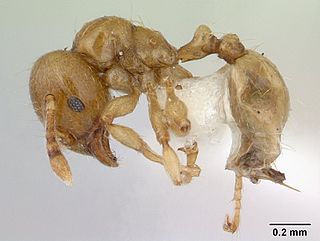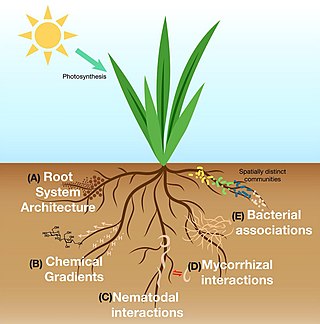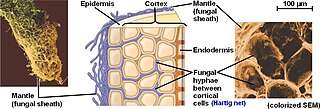Related Research Articles

An endosymbiont or endobiont is any organism that lives within the body or cells of another organism most often, though not always, in a mutualistic relationship. (The term endosymbiosis is from the Greek: ἔνδον endon "within", σύν syn "together" and βίωσις biosis "living".) Examples are nitrogen-fixing bacteria, which live in the root nodules of legumes, single-cell algae inside reef-building corals and bacterial endosymbionts that provide essential nutrients to insects.

Mutualism describes the ecological interaction between two or more species where each species has a net benefit. Mutualism is a common type of ecological interaction. Prominent examples include most vascular plants engaged in mutualistic interactions with mycorrhizae, flowering plants being pollinated by animals, vascular plants being dispersed by animals, and corals with zooxanthellae, among many others. Mutualism can be contrasted with interspecific competition, in which each species experiences reduced fitness, and exploitation, or parasitism, in which one species benefits at the expense of the other.

A mycorrhiza is a symbiotic association between a fungus and a plant. The term mycorrhiza refers to the role of the fungus in the plant's rhizosphere, its root system. Mycorrhizae play important roles in plant nutrition, soil biology, and soil chemistry.

Rhizobia are diazotrophic bacteria that fix nitrogen after becoming established inside the root nodules of legumes (Fabaceae). To express genes for nitrogen fixation, rhizobia require a plant host; they cannot independently fix nitrogen. In general, they are gram negative, motile, non-sporulating rods.

An arbuscular mycorrhiza (AM) is a type of mycorrhiza in which the symbiont fungus penetrates the cortical cells of the roots of a vascular plant forming arbuscules.

Root hair, or absorbent hairs, are outgrowths of epidermal cells, specialized cells at the tip of a plant root. They are lateral extensions of a single cell and are only rarely branched. They are found in the region of maturation, of the root. Root hair cells improve plant water absorption by increasing root surface area to volume ratio which allows the root hair cell to take in more water. The large vacuole inside root hair cells makes this intake much more efficient. Root hairs are also important for nutrient uptake as they are main interface between plants and mycorrhizal fungi.

Allomerus decemarticulatus is an Amazonian ant species found in the tropics of South America. This species is most notable for the workers’ complex and extreme predatory behavior, which involves a symbiosis with both a plant and fungal species. They live in leaf pockets of a host plant species, Hirtella physophora. These leaf pockets are areas inside of the plant between the leaves and the stem. Each colony, which consists of about 1,200 workers, inhabits a single tree; however, the ants are spread among the leaf pockets, with typically 40 workers per pocket. Their diet primarily consists of large insects that are captured on the plant, but they also eat some kinds of food bodies produced by the plant as well as its nectar. They are able to capture their prey, which is much larger than themselves, by constructing a platform that acts as a trap for the unsuspecting prey. The ants hide in the trap and attack when any insect lands on it. This technique is an example of ambush predation.

The rhizosphere is the narrow region of soil or substrate that is directly influenced by root secretions and associated soil microorganisms known as the root microbiome. Soil pores in the rhizosphere can contain many bacteria and other microorganisms that feed on sloughed-off plant cells, termed rhizodeposition, and the proteins and sugars released by roots, termed root exudates. This symbiosis leads to more complex interactions, influencing plant growth and competition for resources. Much of the nutrient cycling and disease suppression by antibiotics required by plants, occurs immediately adjacent to roots due to root exudates and metabolic products of symbiotic and pathogenic communities of microorganisms. The rhizosphere also provides space to produce allelochemicals to control neighbours and relatives.
Glomus is a genus of arbuscular mycorrhizal (AM) fungi, and all species form symbiotic relationships (mycorrhizae) with plant roots. Glomus is the largest genus of AM fungi, with ca. 85 species described, but is currently defined as non-monophyletic.
Microbial inoculants also known as soil inoculants or bioinoculants are agricultural amendments that use beneficial rhizosphericic or endophytic microbes to promote plant health. Many of the microbes involved form symbiotic relationships with the target crops where both parties benefit (mutualism). While microbial inoculants are applied to improve plant nutrition, they can also be used to promote plant growth by stimulating plant hormone production. Although bacterial and fungal inoculants are common, inoculation with archaea to promote plant growth is being increasingly studied.
Trophic mutualism is a key type of ecological mutualism. Specifically, "trophic mutualism" refers to the transfer of energy and nutrients between two species. This is also sometimes known as resource-to-resource mutualism. Trophic mutualism often occurs between an autotroph and a heterotroph. Although there are many examples of trophic mutualisms, the heterotroph is generally a fungus or bacteria. This mutualism can be both obligate and opportunistic.

Hartig net is a network of inward-growing hyphae, that extends into the root, penetrating between the epidermis and cortex of ectomycorrhizal plants. This network is a site of nutrient exchange between the fungus and the host plant. The Hartig net is one of the three components required for ectomycorrhizal roots to form as part of ectomycorrhizal symbiosis with the host tree or plant.

A mycorrhizal network is an underground network found in forests and other plant communities, created by the hyphae of mycorrhizal fungi joining with plant roots. This network connects individual plants together. Mycorrhizal relationships are most commonly mutualistic, with both partners benefiting, but can be commensal or parasitic, and a single partnership may change between any of the three types of symbiosis at different times.

An ectomycorrhiza is a form of symbiotic relationship that occurs between a fungal symbiont, or mycobiont, and the roots of various plant species. The mycobiont is often from the phyla Basidiomycota and Ascomycota, and more rarely from the Zygomycota. Ectomycorrhizas form on the roots of around 2% of plant species, usually woody plants, including species from the birch, dipterocarp, myrtle, beech, willow, pine and rose families. Research on ectomycorrhizas is increasingly important in areas such as ecosystem management and restoration, forestry and agriculture.
Mesorhizobium mediterraneum is a bacterium from the genus Mesorhizobium, which was isolated from root nodule of the Chickpea in Spain. The species Rhizobium mediterraneum was subsequently transferred to Mesorhizobium mediterraneum. This species, along with many other closely related taxa, have been found to promote production of chickpea and other crops worldwide by forming symbiotic relationships.

The root microbiome is the dynamic community of microorganisms associated with plant roots. Because they are rich in a variety of carbon compounds, plant roots provide unique environments for a diverse assemblage of soil microorganisms, including bacteria, fungi and archaea. The microbial communities inside the root and in the rhizosphere are distinct from each other, and from the microbial communities of bulk soil, although there is some overlap in species composition.
Orchid mycorrhizae are endomycorrhizal fungi which develop symbiotic relationships with the roots and seeds of plants of the family Orchidaceae. Nearly all orchids are myco-heterotrophic at some point in their life cycle. Orchid mycorrhizae are critically important during orchid germination, as an orchid seed has virtually no energy reserve and obtains its carbon from the fungal symbiont.

Mycorrhiza helper bacteria (MHB) are a group of organisms that form symbiotic associations with both ectomycorrhiza and arbuscular mycorrhiza. MHBs are diverse and belong to a wide variety of bacterial phyla including both Gram-negative and Gram-positive bacteria. Some of the most common MHBs observed in studies belong to the phylas Pseudomonas and Streptomyces. MHBs have been seen to have extremely specific interactions with their fungal hosts at times, but this specificity is lost with plants. MHBs enhance mycorrhizal function, growth, nutrient uptake to the fungus and plant, improve soil conductance, aid against certain pathogens, and help promote defense mechanisms. These bacteria are naturally present in the soil, and form these complex interactions with fungi as plant root development starts to take shape. The mechanisms through which these interactions take shape are not well-understood and needs further study.
Mycorrhizal amelioration of heavy metals or pollutants is a process by which mycorrhizal fungi in a mutualistic relationship with plants can sequester toxic compounds from the environment, as a form of bioremediation.
The International Collection of (Vesicular) Arbuscular Mycorrhizal Fungi (INVAM) is the largest collection of living arbuscular mycorrhizal fungi (AMF) and includes Glomeromycotan species from 6 continents. Curators of INVAM acquire, grow, identify, and elucidate the biology, taxonomy, and ecology of a diversity AMF with the mission to expand availability and knowledge of these symbiotic fungi. Culturing AMF presents difficulty as these fungi are obligate biotrophs that must complete their life cycle while in association with their plant hosts, while resting spores outside of the host are vulnerable to predation and degradation. Curators of INVAM have thus developed methods to overcome these challenges to increase the availability of AMF spores. The inception of this living collection of germplasm occurred in the 1980s and it takes the form of fungi growing in association with plant symbionts in the greenhouse, with spores preserved in cold storage within their associated rhizosphere. AMF spores acquired from INVAM have been used extensively in both basic and applied research projects in the fields of ecology, evolutionary biology, agroecology, and in restoration. INVAM is umbrellaed under the Kansas Biological Survey at The University of Kansas, an R1 Research Institution. The Kansas Biological Survey is also home to the well-known organization Monarch Watch. INVAM is currently located within the tallgrass prairie ecoregion, and many collaborators and researchers associated with INVAM study the role of AMF in the mediation of prairie biodiversity. James Bever and Peggy Schultz are the Curator and Director of Operation team, with Elizabeth Koziol and Terra Lubin as Associate Curators.
References
- ↑ Currie, Cameron R.; Wong, Bess; Stuart, Alison E.; Schultz, Ted R.; Rehner, Stephen A.; Mueller, Ulrich G.; Sung, Gi-Ho; Spatafora, Joseph W.; Straus, Neil A. (2003-01-17). "Ancient Tripartite Coevolution in the Attine Ant-Microbe Symbiosis". Science. 299 (5605): 386–388. Bibcode:2003Sci...299..386C. doi:10.1126/science.1078155. ISSN 0036-8075. PMID 12532015. S2CID 15815635.
- ↑ Ruiz-González, Mario X.; Malé, Pierre-Jean G.; Leroy, Céline; Dejean, Alain; Gryta, Hervé; Jargeat, Patricia; Quilichini, Angélique; Orivel, Jérôme (2011-06-23). "Specific, non-nutritional association between an ascomycete fungus and Allomerus plant-ants". Biology Letters. 7 (3): 475–479. doi:10.1098/rsbl.2010.0920. ISSN 1744-9561. PMC 3097849 . PMID 21084334.
- ↑ Leroy, Céline; Séjalon-Delmas, Nathalie; Jauneau, Alain; Ruiz-González, Mario-Xavier; Gryta, Hervé; Jargeat, Patricia; Corbara, Bruno; Dejean, Alain; Orivel, Jérôme (December 2010). "Trophic mediation by a fungus in an ant-plant mutualism: Fungal mediation in a tripartite mutualism". Journal of Ecology: no. doi: 10.1111/j.1365-2745.2010.01763.x . S2CID 83551088.
- ↑ "Exploring fungus–plant N transfer in a tripartite ant–plant–fungus mutualism" . Retrieved 2022-09-29.
- ↑ Henskens, Frieda L.; Green, T. G. Allan; Wilkins, Alistair (August 2012). "Cyanolichens can have both cyanobacteria and green algae in a common layer as major contributors to photosynthesis". Annals of Botany. 110 (3): 555–563. doi:10.1093/aob/mcs108. ISSN 0305-7364. PMC 3400443 . PMID 22648879.
- ↑ Rikkinen, Jouko (2015-04-01). "Cyanolichens". Biodiversity and Conservation. 24 (4): 973–993. doi:10.1007/s10531-015-0906-8. ISSN 1572-9710. S2CID 254277998.
- ↑ Ponsero, Alise J.; Hurwitz, Bonnie L.; Magain, Nicolas; Miadlikowska, Jolanta; Lutzoni, François; U’Ren, Jana M. (2021-10-15). "Cyanolichen microbiome contains novel viruses that encode genes to promote microbial metabolism". ISME Communications. 1 (1): 1–4. doi:10.1038/s43705-021-00060-w. ISSN 2730-6151. S2CID 235465561.
- ↑ Takács, Tünde; Cseresnyés, Imre; Kovács, Ramóna; Parádi, István; Kelemen, Bettina; Szili-Kovács, Tibor; Füzy, Anna (2018). "Symbiotic Effectivity of Dual and Tripartite Associations on Soybean (Glycine max L. Merr.) Cultivars Inoculated With Bradyrhizobium japonicum and AM Fungi". Frontiers in Plant Science. 9: 1631. doi: 10.3389/fpls.2018.01631 . ISSN 1664-462X. PMC 6243127 . PMID 30483288.
- ↑ Varennesa, A. D.; Gossb, M. J. (2007). "The tripartite symbiosis between legumes , rhizobia and indigenous mycorrhizal fungi is more efficient in undisturbed soil". www.semanticscholar.org. S2CID 52247765 . Retrieved 2022-09-29.
- ↑ Hao, Zhipeng; Xie, Wei; Jiang, Xuelian; Wu, Zhaoxiang; Zhang, Xin; Chen, Baodong (October 2019). "Arbuscular Mycorrhizal Fungus Improves Rhizobium–Glycyrrhiza Seedling Symbiosis under Drought Stress". Agronomy. 9 (10): 572. doi: 10.3390/agronomy9100572 . ISSN 2073-4395.
- ↑ "Increasing plant tolerance grown on saline soil: the role of tripartite symbiosis". www.cabdirect.org. Retrieved 2022-09-30.